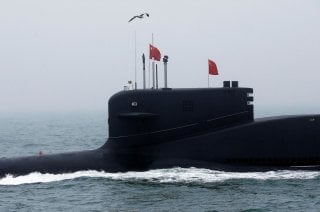Yes China Does Have Robot Submarines and They're Ready for Battle
Of course, so does America.
Key point: These submarines are an important part of Beijing's many armed drones. Here's what they can do.
You May Also Like: 5 Best Submarines of All Time, 5 Best Aircraft Carriers of All Time, 5 Best Battleships of All Time and Worst Submarine of All Time.
China as part of its Oct. 1, 2019 national anniversary celebration revealed a new class of large robotic submarine.
This first appeared in 2019 and is being reposted due to reader interest.
The unmanned underwater vehicle apparently is in the same class as UUVs that the United States and the United Kingdom also are developing -- and could help the Chinese fleet to match the U.S. and U.K. fleets in undersea warfare.
At least two copies or mockups of the Chinese UUV, reportedly designated HSU-001, appeared on flatbed trucks in the military parade through Beijing.
"If it's real, and I assume it's probably real, it looks like it's designed mostly for intelligence gathering." Bryan Clark, an analyst with the Center for Strategic and Budgetary Assessments in Washington, D.C., told Business Insider.
At around 15 feet in length, the HSU-001 probably isn’t big enough to carry weapons such as torpedos or mines. "It doesn't really look like it's made for mine-laying," Clark said.
Clark told Business Insider China most likely would deploy a large UUV in the East China Sea, where its long endurance -- potentially several weeks or months -- could allow it to gather intelligence on Japan and, presumably, U.S. forces in Japan.
The development of this large UUV means China has been paying a lot of attention to the growth of its anti-submarine warfare capability, Collin Koh, research fellow with the Maritime Security Programme at Singapore’s S. Rajaratnam School of International Studies, told the Hong Kong South China Morning Post.
“[It] could pose a challenge to prospective adversaries such as the U.S. Navy and allied underwater activities in waters near the Chinese coast, such as the East China Sea and South China Sea,” Koh said.
American and British UUVs are much bigger than the HSU-001 is. But they have to be, as they would need to sail long distances in order to reach potential conflict zones. The larger size also gives the U.S. and U.K. robo-subs greater potential for carrying weapons.
The U.S. Navy between 2020 and 2024 wants to spend around $4 billion buying nine unmanned submarines as well as 10 unmanned surface warships.
The robotic vessels could help the Navy to grow the fleet despite proposed cuts and slowdowns in the acquisition of traditional manned vessels. Senior Navy leaders increasingly worry that big warships, some crewed by hundreds of sailors, are too vulnerable to Russian and Chinese missiles.
The Navy already has tapped Boeing to build the robotic submarines, using the company’s Orca design as a starting point. The 51-foot-long Orca autonomously can sail as far as 6,500 nautical miles.
"Eventually, the Navy could also use the Orca ... for mine countermeasures, anti-submarine warfare, anti-surface warfare, electronic warfare and strike missions, according to a Navy outline of the system’s capability development," reporter Ben Werner explained at USNI News.
The U.K. Ministry of Defense in April 2019 launched a $3.3-million competition to begin developing its own robotic submarine.
The contest could lead to the acquisition of an operational autonomous sub for the Royal Navy -- and could help the British fleet partially to fill the undersea gap resulting from deep cuts to its sub force.
The ministry asked industry by June 2019 to submit proposals for an extra-large unmanned underwater vehicle, or XLUUV.
“The Royal Navy says that contract will have two stages, a one-year long research, design and refit stage and a testing and trialing stage,” U.K. Defense Journal explained. “In the latter stage it is expected that the system will be tested in representative environments for extended periods; the sea trials in stage two may be up to two years long.”
The government’s request for proposals sketched three different operational scenarios for the possible, future robo-sub.
In the covert intelligence-gathering role, the XLUUV “is tasked to gather covert intelligence of traffic transiting in a maritime operational area,” according to the RFP.
In the anti-submarine role, the XLUUV “is tasked with enacting an anti-submarine barrier in a particular location,” the RFP explained.
Finally, in the “deploy and recover” role, the robotic submarines “is tasked with covertly deploying a sensor payload to the seabed and recovering it at a later date,” according to the government request.
Even given the disparity in sizes between U.S. and U.K. UUVs compared to China’s UUV, the roles the United States and United Kingdom are considering for their own robotic submarines could hint at the missions China assigns to its own class of undersea drone.
“Its job will be similar to U.S. submersibles,” one military analyst told South China Morning Post.
David Axe serves as Defense Editor of the National Interest. He is the author of the graphic novels War Fix, War Is Boring and Machete Squad. This first appeared in 2019 and is being reposted due to reader interest.
Image: Reuters

